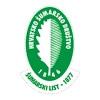
DIGITALNA ARHIVA ŠUMARSKOG LISTA
prilagođeno pretraživanje po punom tekstu
| ŠUMARSKI LIST 7-8/1997 str. 14 <-- 14 --> PDF |
V Topic: UPOTREBLJIVOST AUTOKTONIH LISTAČA PRI POŠUML.IAVANJU KRŠA Šumarski list br. 7-8, CXXI (1997), 343-352 Tomašević, A., 1983: Rezultati ljetne pokusne sadnje Vrdoljak, Ž., 1952: Krš i njegovo pošumljavanje, biljaka na našem submediteranskom području, Split. Šumarski list, 7-8, Zagreb. Vrdoljak, Ž., 1954: Nekoliko napomena za uzgoj To m a š e v i ć, A., 1986: Rekultivacije kraških goleti po- rašeljke, Šumarski list, 7, Zagreb. šumljavanjem u SR Hrvatskoj, Glasnik za šumske pokuse, posebno izdanje, 2, Zagreb. Vrdoljak, Z., 1955: Prilog poznavanju tehnike po- šumljavanja srednjodalmatinske kamenjare, Ana- Tomašević, A., 1993: Pinija (P.nus pinea L.) kao vrsta {{ ^^ za eksperimentalno šumarstvo JAZU, za pošumljavanje krša, Šumarski list, 6-8, Zagreb. Topić, V, 1988: Upotrebljivost nekih autoktonih i w . ,. , * ,„,„ „,...., , , . « 11 , r , , - ,. , Vrdohak, Z., 1959: Cedrovi i niihova važnost za aloktonih šumskih vrsta kod posumljavanj a sub- J ..... , . . ,. ., » mediteranskog krškog područja Dalmacije, Dok- podizanje vrijednosti degradiramh suma i posum- torska dizertaciia ljavanje u području submediterana, "Obavijest -r ,, ,„„„ r, , -, v . v , instituta za šumarska i lovna istraživanja, 7, Topic, V., 1990: Prirast nekih vrsta cetmiaca na sub- „ J mediteranskom kraškom području Dalmacije, s Šumarski list, 11-12, 441-450,Zagreb. Vrdoljak, Ž., 1967: Istraživanje u uzgoju sadnica V i d a k o v i ć, M., 1972: Novi pogledi na pošumljavanje košćele i rašeljke, Šumarski list, Zagreb. degradiranog krša, Šumarski list, Zagreb. SUMMARY: The afforestation ofkarst is very important not only because of useful functions of woods, which take central part in that area, but also because of the economic values of these areas, which can became important national resource for wood production. One of the main problems which must be solved is the right choice of species. The former Institute for experimental forestry founded more experimental plots on the karst, among them the experimental plot Klačine in 1956, on which the results were obtained, after many years of investigation. The experimental were made with deciduous plants and with native and foreign coniferous trees. The results were published (Topic, 1990). The experimental plot Klačine is on the area of forestry Sinj. It is situated on the slopes of the right side of the river Cetina, with the highest top of 395 m. It is apart of the amelioration area Klačine, of the entire area of 40 ha. The afforestation on the experimental plot was done in spring 1958. In the goelogical sense, the plot is quite homogenous and is made of limestones with dolomites, on which are brown soils. According Koppen, this area belongs to the warm and moderate warm climatic zone and according to the rain factor into the humid climate. During the vegetation period 500 mm or 40,55% of the entire rainfall fall. The area on which the plot lies belongs to the mediterranean-mountain area of the deciduous vegetation of (Ostryo-Carpinion orientalis). The investigations include seven native deciduous plants Oak downy (Quercus pu- bescens Willd.), Hornbeam orientalis (Carpinus orientalis Mill.), Ash flowering (Fraxinus ornus L.), Hornbeam hop (Ostrya carpinifolia Scop.), Mahaleb cherry tree (Prunus mahaleb L.), Montpellier (Acer monspessulanum L.) and Southern celtis (Celtis australis). The trees were measured in the I., 11., 18. and 33. year. The results obtained show that the quoted species, although they are native, grow very slowly, because young plants of these species do not endure degraded soil and in such conditions they die or just exist. Better success, compared with the other deciduous plants, had Hornbeam hop. With the average height of 5,74 m in the 33. year it overtops the other deciduous plants. The greatest height, after Hornbeam hop were reached by Ash flowering and Hornbeam oriental. Ash flowering had an average height of 4,28 m in the 33. year and Hornbeam oriental nearly follows it with the height and diameter. Oak downy, as the most useful deciduous wood plant in this area, had in the 11. year only 59 cm height and in the 33. year 3,11 m. Mahaleb cherry tree, although it is regarding the number of survived plants, the leading wood plant, grows very slowly. Its average height in the 33. year was 2,95 m. Montpellier grows even worse than Mahaleb cherry tree and Southern Celtics decayed completely. Key words: native deciduous plants, afforestation of karst, Oak downy, Hornbeam oriental, Ash flowering, Hornbeam hop, Mahaleb cherry tree, Montpellier, Southern Celtics, growth. 352 |